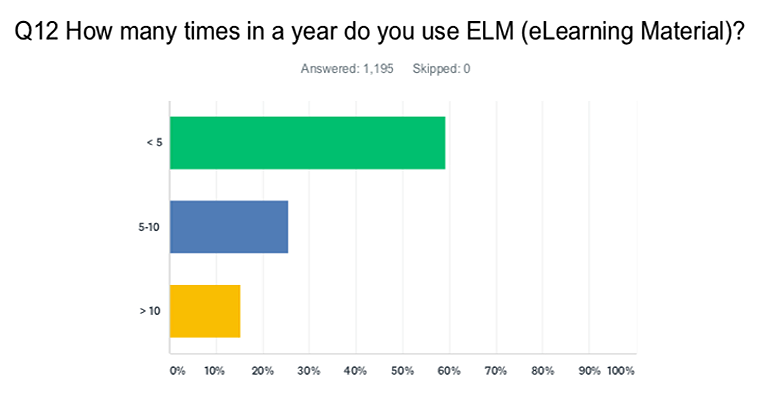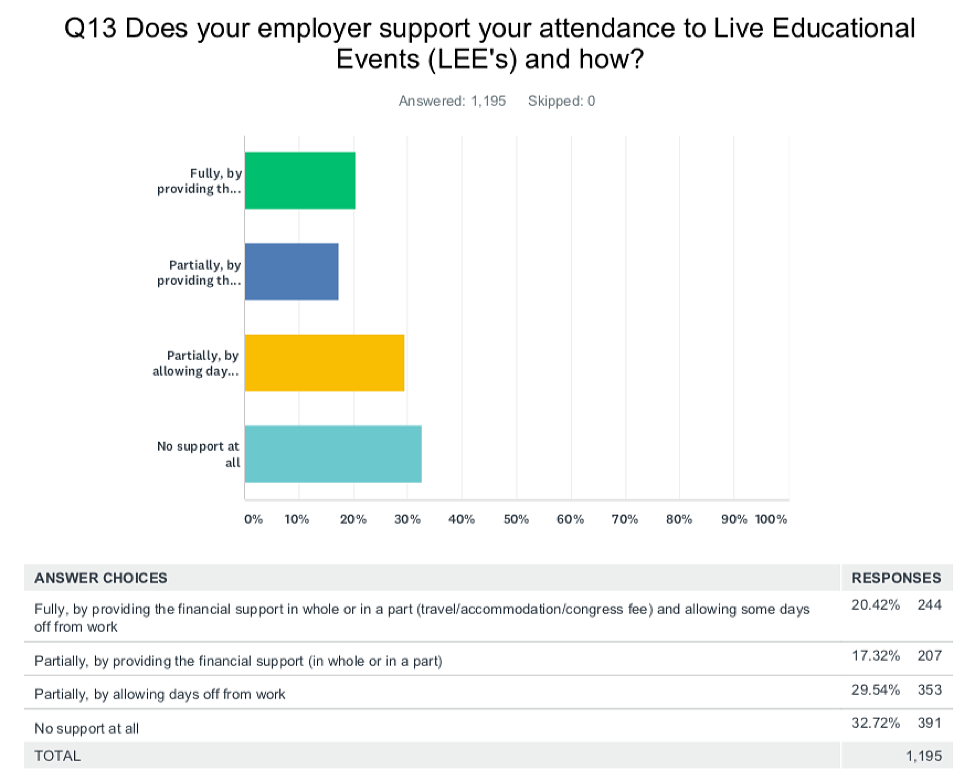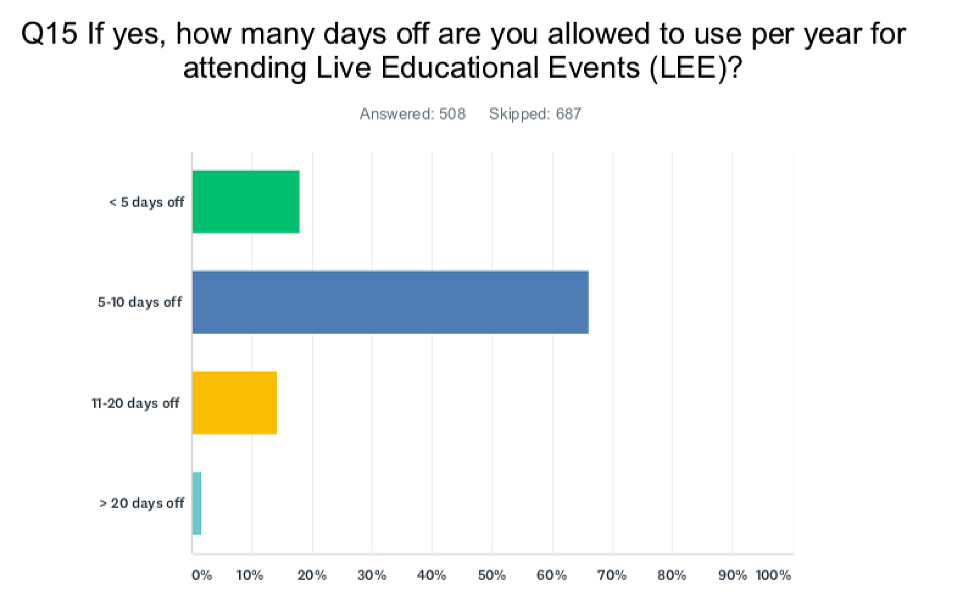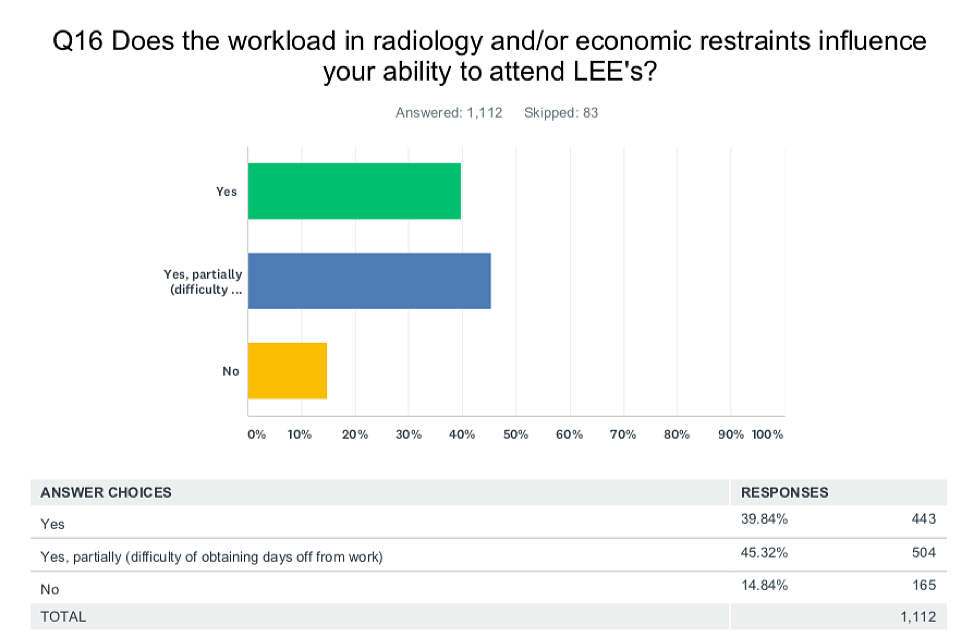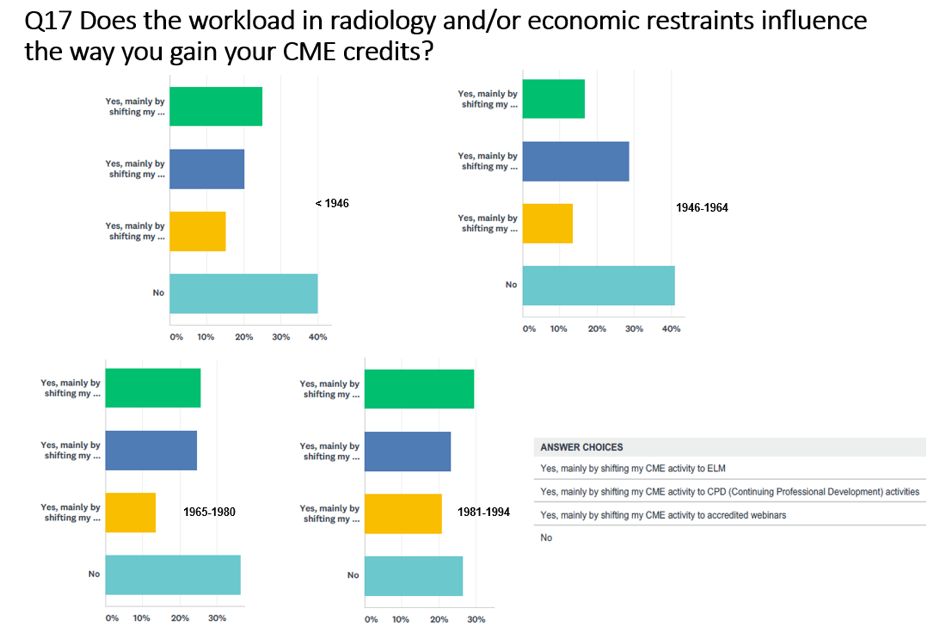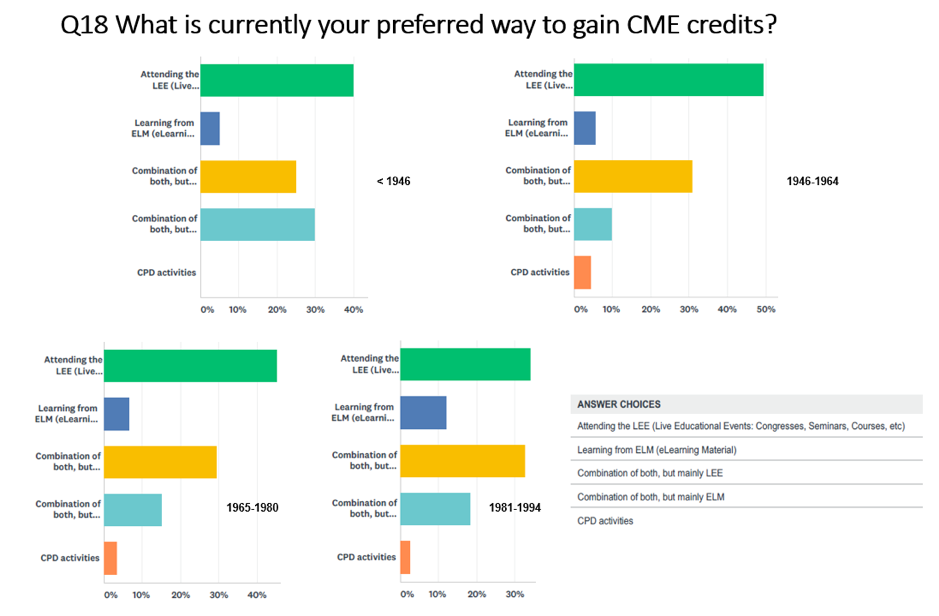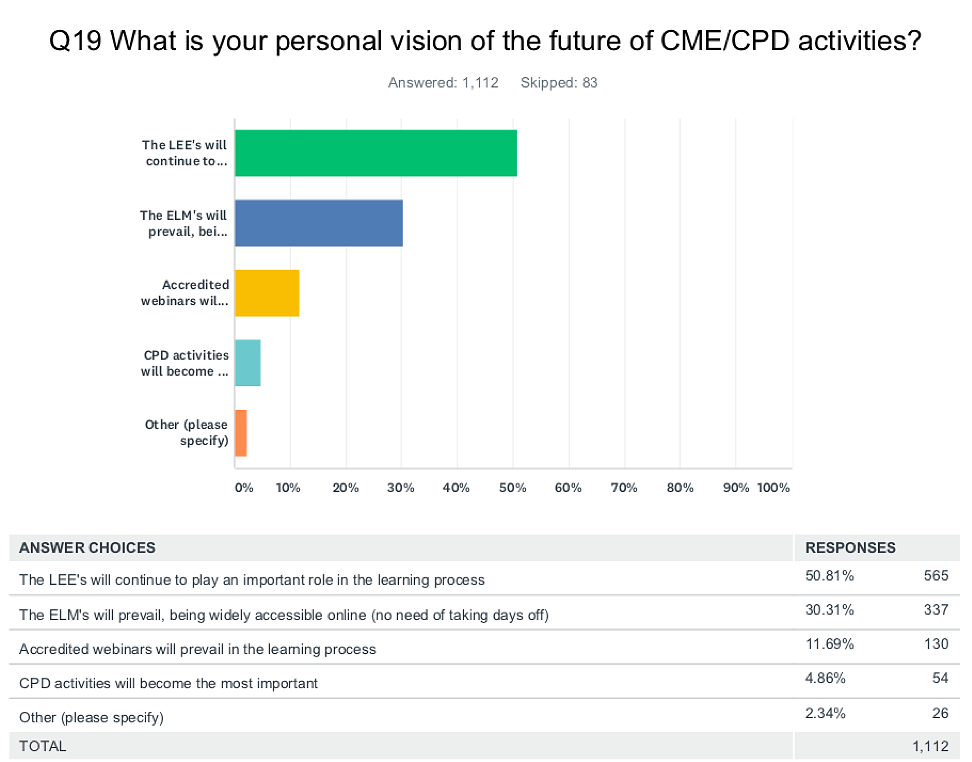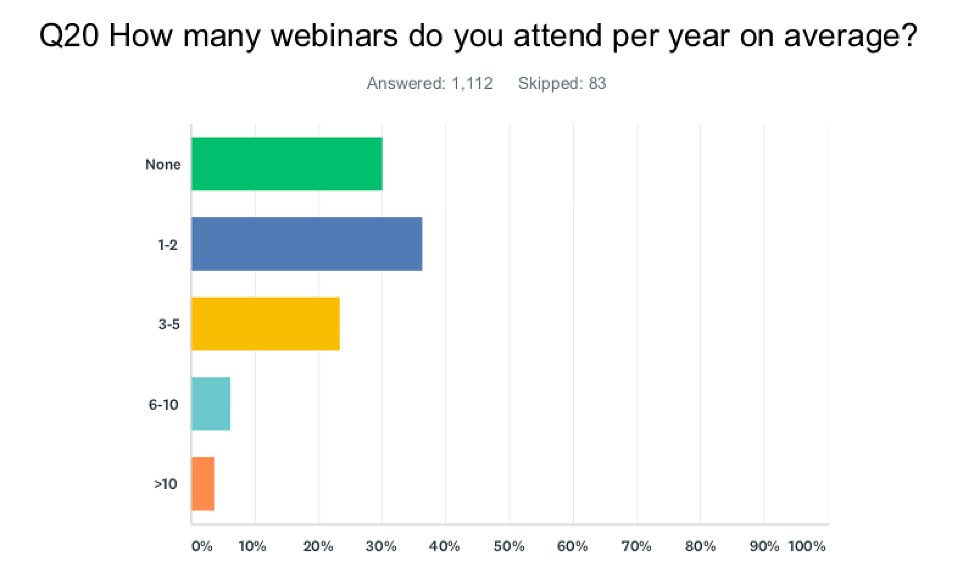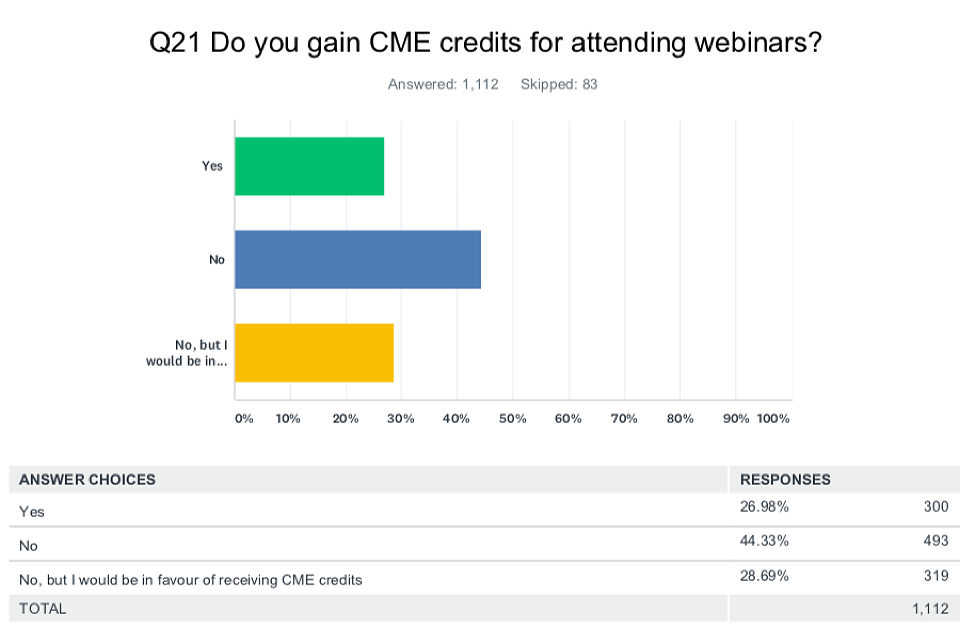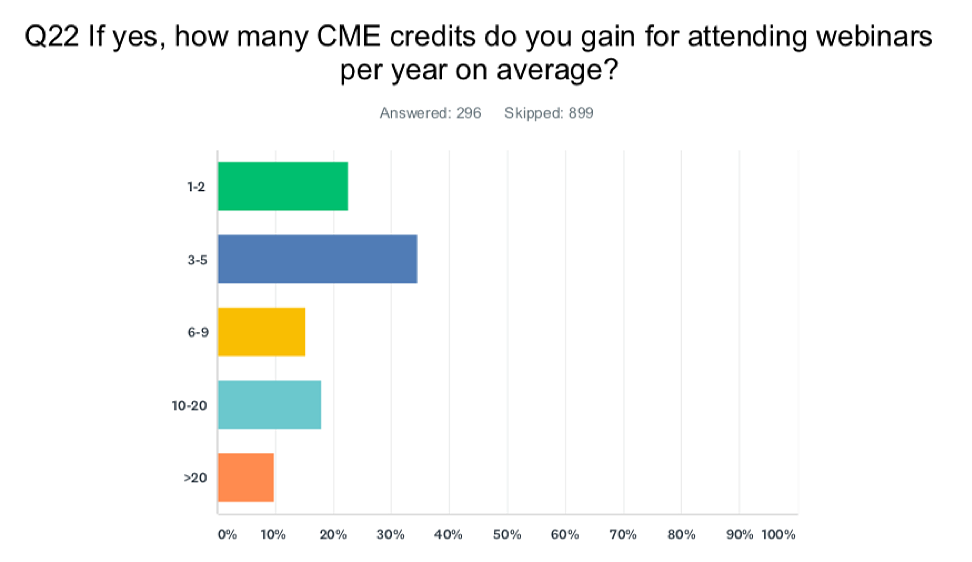What is the future of continuing medical education in Europe?

See also other articles:
- The European Board of Radiology: Evolution over 7 years
- The European Diploma in Radiology (EDiR): Investing in the future of upcoming generations of radiologists
- Be better prepared for the EDiR: New EDiR app and new content on the EBR blog from October 15 on!
- ETAP 2.0: It’s time for health institutions in Europe and beyond to harmonise their radiology training programmes
What is the future of continuing medical education in Europe?
Survey conducted by the Accreditation Council in Imaging (ACI)
Recognising the globally emerging generation shift not only in radiology, but also in the generation-dependent level of readiness to use current and future technologies in radiology and education, including learning concepts and preferences, the Accreditation Council in Imaging (ACI) conducted a survey in June 2018 on the future of Continuing Medical Education (CME) and Continuing Professional Development (CPD). The aim of the survey is to provide a better understanding of the contemplations and preferences of radiologists in Europe with regard to CME/CPD learning processes. We also sought to obtain rather basic and initial information on webinars, an increasingly popular learning modality, as well as to gain an insight into current conditions and possibilities for attending Live Educational Events (LEEs) and to anticipate the preferred concepts and/or emerging preferences of European radiologists regarding CME/CPD acquisition in the future.
The survey was sent to all ESR individual members in Europe. The ACI received 1,195 responses from ESR members (999 radiologists (88.72%), and 127 radiology residents (11.28%)) from 42 different European countries.
The aim of the survey analysis was to anticipate upcoming trends regarding CME/CPD activities and processes, using as a reference the distribution between generations. We would therefore like to thank all respondents for their valuable contribution to the survey.
Considering ‘generation’ as a group of people born around the same time and raised with approximately the same values and shaped by key trends of parenting, technology and economics, we have tried to simplify the generation divisions in the survey, being fully aware, however, that generation divisions are rather troublesome as regards not only geographical or economic circumstances, but also because of the multitude of other variations and differences.
We decided to follow technology advances, primarily not only as an important tool in both radiology and educational processes in radiology, but also as a common denominator and landmark of every upcoming generation, and with particular consideration given to the ingenious “set of rules” of Douglas Adams (1952–2001) that describe our reactions to technology:
– Anything that is in the world when you’re born is normal and ordinary and is just a natural part of the way the world works.
– Anything that’s invented between when you’re fifteen and thirty-five is new and exciting and revolutionary and you can probably get a career in it.
– Anything invented after you’re thirty-five is against the natural order of things.
Therefore, given the undeniable fact that not only radiology, but our whole world, is becoming technology-oriented and technology-based, we applied the generation scaling that is generally accepted in global social sciences terminology, dividing the generation distribution into various groups: the so-called Silent Generation/Traditionalists, born before 1946; Boomers/Baby Boomers, born between 1946 and 1964; Generation X, born between 1965 and 1980; Generation Y, also known as Millennials, born between 1981 and 1994 and Generation Z, born after 1994.
Based on the respondents’ age, the still prevailing majority belongs to the Boomers/Baby Boomers (represented by 30.99% of respondents), Generation X (45.91% of respondents) and Generation Y/Millennials (21.23% of respondents), while the Silent Generation/Traditionalists group accounted for 1.69% of respondents. Apparently, Generation Z has still not fully entered into our professional specialty, with only 2 respondents (0.18%), which does not currently provide a sufficiently representative number to reflect opinion trends. For this reason we did not conduct a separate Generation Z group analysis and the answers received from this generation group were only included in the overall results.
(Graphic 1)
The overall results of the survey indicate that most respondents know how to earn CME credits (68.56%). However, in regard to the generation groups, it is evident that the best-informed radiology population are the older generation groups —Silent Generation/Traditionalists (80.95%), Boomers/Baby Boomers (78.73%) and Generation X (71.15%)— in comparison to Generation Y, with a much lower number of informed respondents (47.62%). It is also notable that in the same group the lack of knowledge about how to obtain CME credits, or the need for more information, is over 50% (52.38%). This unexpected fact is a cause for alarm, and should be understood as an immediate “call for action”, to inform younger generations of radiologists about how to earn CME credits.
(Graphic 2)
* Respondents born between 1981–1994 (Generation Y/Millennials)
In regard to Continuing Professional Development (CPD), the overall results are not very promising. Only around one-third of respondents is informed on how to acknowledge their CPD activities and how to convert them into CME credits, while almost two-thirds are either unaware or need more information. It cannot be ignored that knowledge of converting CPD activities to CME credits decreases the younger the respondents are, with 61.90% awareness among the Silent Generation/Traditionalists generation group, 48.34% among the Boomers/Baby Boomers generation, 31.61% among Generation X, and only 21.84% among Generation Y. The fact that CPD activities —currently recognised by the UEMS and which can be converted into CME credits— are mostly available to more experienced radiologists could partly explain the observed trend, but action in this area to promote CPD activities and to make the CPD to CME conversion process more transparent is needed.
(Graphic 3)
Although we are aware that there are differences between the accreditation systems in Europe, that they vary from country to country and that in some countries CME/CPD is not mandatory, our survey still demonstrated interesting results regarding the personal opinions of European radiologists on the requirement to collect a defined number of CME credits per year.
The overall results indicate a very small gap between two fully opposed standpoints regarding mandatory CME requirements: “It is an obligation that I am required to fulfil” (36.68%), and “It is a self-improvement activity that improves my daily work and professional skills” (42.10%). This gap is more pronounced in the Silent Generation/Traditionalists and Boomers/Baby Boomers groups, where 57.14% and 41.71% of respondents, respectively, believe that CME credits should be mandatory, while 33.33% and 40.06%, respectively, see it as a “self-improvement activity”. We have also observed an increasing positive trend among Generation X, who perceive CME as a “self-improvement activity” (41.76%) as opposed to an “obligation” (34.77%). This positive trend is even greater among Generation Y respondents, who perceive it as a “self-improvement activity” (47.62%) as opposed to an “obligation” (30.56%).
This trend actually gives us an optimistic insight into CME/CPD activities, which are seen as a part of professional improvement, with higher awareness among the younger generation groups.
(Graphic 4)
With regard to CME credits obtained through attending Live Educational Events (LEEs) and E-Learning Materials, it appears that the great majority of radiologists and other radiology professionals, regardless of generation distribution, are still earning the largest number of CME credits in a traditional way, i.e. by attending LEEs, which includes congresses, seminars, courses and schools. We can see a slight shift among Generation Y respondents, as they indicate that the number of CME credits earned by attending LEEs is mostly 30–60%, and lower than 60% in comparison to the other three generation groups analysed. This subtle insight together with a slight but observable increasing trend in earning more CME credits through ELM among the younger generation groups, indicates an easy and slow generational shift towards ELM.
Although slightly country dependable, 51.15% of respondents reported that access to CME materials, both LEEs and ELM, is not free of charge. Most respondents attend up to two LEEs per year (48.67%), 39.08% of them 3–5 LEEs per year, 8.35% of them attend 6–10 LEEs per year and only 3.91% attend more than 10 LEEs, with an observable, slightly decreasing trend in the number of LEEs attended by the Generation Y group. In addition, the overall survey results indicate that the majority of respondents use E-Learning Materials (ELM) less than 5 times per year (59.33%), 25.13% 5–10 times, and 15.54% more than 10 times per year. A slight shift towards the increase of ELM use is, however, visible among Generation Y respondents.
(Graphic 5)
Although the data seems to vary slightly between countries, the percentage of respondents that have enough time and resources to attend LEEs is 56.30% in the overall survey results, while the percentage of those that do not have enough time or resources increases from the Boomers/Baby Boomers (38.40%) to the Silent Generation/Traditionalists (42.86%), Generation X (44.62%) and Generation Y (51.19%).
It appears that employers are partially supporting employee attendance at LEEs by providing financial support (in whole or in part) or by allowing days off work (47.25%), but mainly by allowing days off work (29.93%). In 20.16% of cases, the employer provides full support (both financially and allowing days off work), while in 32.59% of cases the employer provides no support at all. Among the Generation Y group, we observe only partial support by allowing days off work (33.33%), with a slight increase in the percentage of no support at all (34.12%). The results from the Silent Generation/Traditionalists are rather unexpected, as the majority of respondents (57.14%) stated that they do not receive any support at all from their employer.
(Graphic 6)
The number of days off work to allow attendance at LEEs is limited in the vast majority of cases (86.63%) and, Europe-wide, this is usually 5-10 days (62.89%).
(Graphic 7)
The overall results demonstrate that workload and/or economic restraints have an impact on the ability of radiologists in Europe to attend LEEs, either fully (39.94%) or partially because of the difficulty in obtaining days off work (45.32%), regardless of generation distribution, leaving only 14.84% of respondents stating that neither workload nor economic restraints have an impact on their ability to attend LEEs. Still, the percentage of radiologists for whom workload and/or economic restraints have an influence, whether fully or partially, increases from the Boomers/Baby Boomers generation group (83.03%) to Generation X (86.62%) and Generation Y (87.90%), while in the Silent Generation/Traditionalists group, the percentage is 50%.
(Graphic 8)
Although the way in which radiologists in Europe earn their CME credits is not influenced by workload and/or economic restraints, in 35.65% of cases in all the observed groups, the majority of respondents (64.35%) state that the influence of the above-mentioned factors has an impact on the way they earn CME credits, mainly by shifting their CME activities to ELM (24.02%), to CPD activities (24.98%), or to accredited webinars (15.35%).
The differences are observable between the groups, as shown in Graphic 9, demonstrating that the most prominent shift towards ELM and webinars is among Generation Y, and we also see a slight decrease of the shift to CPD in comparison to Silent Generation/Traditionalists, Boomers/Baby Boomers and Generation X groups.
(Graphic 9)
The preferred way to earn CME credits in the overall group still appears to be “attendance at LEEs” (44.33%), followed by “combination of LEEs and ELM, but mainly LEEs” (30.89%), while “combination of both LEEs and ELM, but mainly ELM” (14.11%) and “Learning from ELM” (7.34%) were relatively far behind. CPD activities were stated as the preferred way to earn CME credits by only 3.34% of respondents.
Observing the data divided into generation groups, we see a decrease in LEEs as the preferred way to earn CME credits, starting from 40.00% in the Silent Generation/Traditionalists groups, 49.49% in the Boomers/Baby Boomers group and 45.20% in the Generation X group, to 34.08% in the Generation Y group.
A combination of LEEs and ELM, but mainly LEEs, follows a relatively steady trend, starting from 30.65% in the Boomers/Baby Boomers group, 29.57% in the Generation X group and 32.74% in the Generation Y group.
If we analyse the answer options “attendance at LEEs” and “combination of both LEEs and ELM, but mainly LEEs”, we see that attending LEEs is the most preferable CME activity. However, though still dominant and prevailing, we again see a slight decreasing trend (75% in the Silent Generation/Traditionalists group, 80.05% in the Boomers/Baby Boomers group, 74.77% in the Generation X group and 66.82% in the Generation Y group), and that attending LEEs is not the absolute preferred way, with a percentage of 100%.
Surprisingly, the same decreasing trend is observable among the generation groups with regard to CPD activities as the preferred way to earn CME credits, and although it starts with 4.46% among the Boomers/Baby Boomers group, it decreases to 3.39% in the Generation X group, and ends with only 2.69% in the Generation Y group. In the Silent Generation/Traditionalists group, CPD appears to be either totally unrecognised or not the preferred option.
On the other hand, learning from ELM shows an increasing trend, from 5.00% in the Silent Generation/Traditionalists group, 5.65% in the Boomers/Baby Boomers group, 6.78% in the Generation X group and up to 12.11% in the Generation Y group. As for a combination of both LEEs and ELM, but mainly ELM, the trend is also increasing among the generation groups (9.82% in the Boomers/Baby Boomers group, 15.07% in the Generation X group and 18.39% in the Generation Y group).
(Graphic 10)
The current personal vision of European radiologists regarding the future of CME/CPD activities largely supports the opinion that LEEs will continue to play an important role in the learning process (51.76%). This form of CME activity implies direct, both formal and informal, interaction with other colleagues and radiologists — indicated by several respondents as one of the main advantages of LEEs. The opinion that ELMs will prevail because of their wide availability and the fact that they do not require days off work, was indicated by 30.22% of respondents, followed by the opinion that accredited webinars will prevail in the learning process (11.53%). The opinion that CPD activities will become the most important learning activity was supported by 4.29% of respondents. One of the interesting individual comments of the respondents (under the option “Other (please specify)” is that there is no perfect solution for CME/CPD activities, and all of the above-mentioned CME/CPD activities will most probably form part of the future of accredited learning processes. Although CME-accredited ELM platforms and webinars are still not widely accessible, we can see a trend of increase among members of the Generation Y group, who are of the opinion that ELM and webinars will become prevailing CME activities in the future (35.87%/17.49%, respectively), in comparison to the Boomers/Baby Boomers generation group (25%/10.42%, respectively), and Generation X group (32.02%/9.60%, respectively).
(Graphic 11)
Even so, almost one-third (30.22%) of all respondents do not attend webinars at the moment, while most of them (36.51%) attend 1–2 webinars per year, 23.26% attend 3–5 webinars per year, 6.01% attend between 6–10 webinars and 4% of respondents attend more than 10 webinars. Nevertheless, webinar attendance is increasing among Generation Y respondents.
(Graphic 12)
Q4 The majority of respondents do not earn CME credits for attending webinars (72.64%), but 27.93% of them would be in favour of receiving CME credits for attending webinars. Among the 27.36% of respondents who have earned CME credits for attending webinars, regardless of the country of origin, they mostly earned up to 5 CME credits (56.54% in total; 22.26% earned 1–2 CME credits and 34.28% earned 3–5 CME credits), while 14.84% declared to have received 6–9 CME credits, followed by 18.73% with 10–20 credits and 9.89% with >20 CME credits.
(Graphic 13)
The generation shift in every profession, including radiology, based on generationally acquired habits regarding the use of available technology, may generate uncertainty or (in expectation of the introduction of artificial intelligence in radiology) even cause real turmoil in our ability to comprehend and anticipate the emerging shifts, which include learning processes and CME/CPD activities. Nevertheless, we are of the modest opinion that, on the basis of the currently prevailing and slowly developing tendencies, trends and discrete indicators, it may be possible to anticipate generational shifts towards different learning habits and preferences.
Thus, even though all the observed tendencies are relatively discrete, are barely visible or comprehensible, they may still serve as an early indicator that the slow shift towards electronic media in learning processes, together with workload and financial or other restraints, may influence the CME acquisition system in radiology in the future. One setback in our survey is that there were only two respondents in the Generation Z group, so the data collected were not sufficient to represent the behaviour and habits, in terms of education acquisition, of the youngest group entering the radiology profession.
From the survey analysis, we can see that inconsistencies remain with regard to understanding the classification into CME and CPD activities, forcing us to take into consideration that CPD activities and their conversion to CME credits is still under-recognised and insufficiently understood among European radiologists and other radiology professionals. In addition, we can extract from the results that there is a clear need to bring CME/CPD activities closer to the younger generations, and that they should be made more transparent and understandable. There is also a need to focus on the concept of webinars as widely available learning events, but which are still rarely accredited. The accreditation of webinars would reinforce their already evident impact on learning habits among comprehensive generation groups, and would add great value to this relatively new learning format.
Finally, we need to keep in mind that one of the main reasons given by the majority of respondents who declared LEEs as a preferred way of earning CME credits is human interaction. Direct formal and informal communication between colleagues and friends in the radiology profession is considered the key determinant, at both an evolutionary and social level, and it is this that makes us what we really are — human beings.
See also other articles:
- The European Board of Radiology: Evolution over 7 years
- The European Diploma in Radiology (EDiR): Investing in the future of upcoming generations of radiologists
- Be better prepared for the EDiR: New EDiR app and new content on the EBR blog from October 15 on!
- ETAP 2.0: It’s time for health institutions in Europe and beyond to harmonise their radiology training programmes





